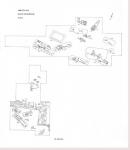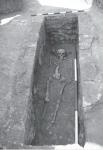Summary (English)
THE SOUTHERN NECROPOLIS OF ABRITUS (Galena Radoslavova – galena_rz@abv.bg, Georgi Dzanev) During the 1980s, nine tumuli were documented in the necropolis, but nowadays only one exists. There were flat graves situated to the east of the tumuli. The first explorations were carried out in 1893 and later – during the 1920s and the 1930s. During 1966 – 1972, some of the tumuli were explored and in 1969, 238 flat graves were excavated (10 were cremations and the rest were inhumations). In 2010, 19 graves of the second half of the 3rd – 4th centuries AD were discovered. The funerary constructions were burial pits (10 graves), a step-like burial pit (grave No. 9), burial pits surrounded with stones or roof-tiles (graves No. 13, 14 and 15), graves covered with roof-tiles (graves Nos. 1, 3 and 17), and a burial pit with walls constructed of bricks bonded with mortar (grave No. 2). The funerary ritual was inhumation. Most bodies were laid supine in wooden coffins, 17 with heads to the west, one with head to the south and one with head to the east. An adult woman was buried in grave No. 2. The grave goods included a jug, a necklace of four amber and 85 glass beads, a bronze bracelet, and a bone bracelet with gilded silver plating. A young woman was buried in grave No. 6. The grave goods included a gold pendant with encrusted quartz, two bronze bracelets, a glass vessel and a circular lead plate with a hole for hanging on the chest. A child was buried in grave No. 9. The grave goods included a bronze fibula, beads, a silver medallion and a copper clasp for a necklace. A man, c. 1.83 in height, was buried in grave No. 15. The grave goods included bronze belt buckle and belt point. A corner of a house was discovered and its foundations had destroyed several graves. Judging from the coins of Valentinian I, Valens, Arcadius and Theodosius II and the coins with AE4 nominal minted in AD 375 – 498, the building dated to the end of the 4th – 5th centuries AD.
- Galena Radoslavova - Regional Museum of History – Razgrad
- Georgi Dzanev - Regional Museum of History – Razgrad
Director
Team
Research Body
- Regional Museum of History – Razgrad






![Download [PDF]](/excavation/skins/fasti/images/results/download_sml.png)

